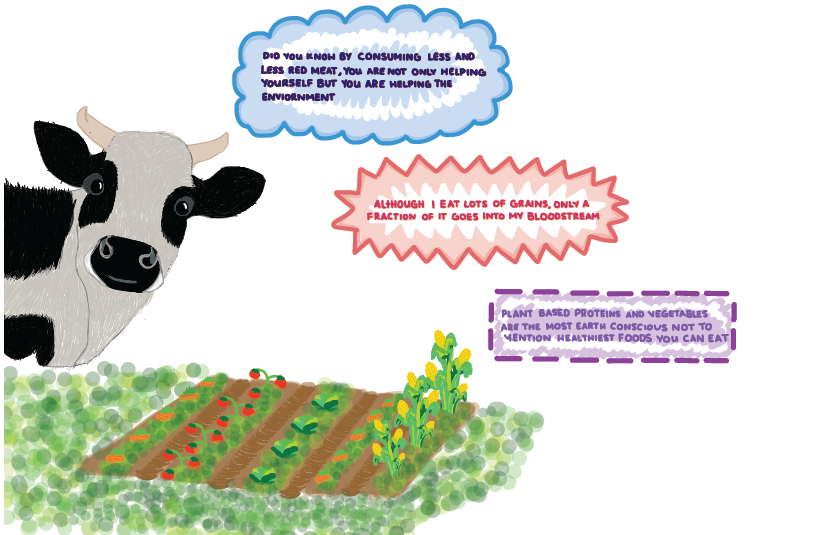Why we need to cut back on eating red meat
October 12, 2017
Cows. Images of black and white blotched, peaceful, and happy bovine are branded into our minds from billboards, ice cream cartons, and little paper boxes of “sweet-cream” butter.
Merely a marketing trick are the pictures of careless cattle, grazing freely upon miles and miles of thick meadows of dewy grass.
Our perception of agriculture in the United States is so far out of line, that most people are completely unaware of where their food is coming from.
This is taking a toll on our environment and our health so severe that it needs to be addressed before you take your lunch break. Let’s talk about how.
First of all, it’s important to mention that the global human population is steadily increasing. As a result, those people need to be fed in the most efficient way possible, since the size of the Earth is not increasing.
Fortunately, thanks to science, Thomas Malthus, who infamously had predicted that we would suffer an apocalypse due to our exponentially rising population and arithmetically rising food production levels, was wrong.
Instead, the industry developed GMOs, pesticides, fertilizers, and machinery that all contribute to a faster process of food production.
With the technology we have today, it is physically possible to adequately feed every single human being on this earth, easily.
The problem arises when American appetites are concerned, because they tend to favor the most unhealthy, climate damaging choices on the market: burgers, steaks, ice cream, cheese, hot dogs, roast beef, jerky, the list goes on.
And they all come from the same animal— cows.
“A 2006 report from the Food and Agriculture Organization estimated that livestock were responsible for about 18% of human-caused greenhouse gases — a figure that has been criticized by the meat industry as too high and by some environmentalists as far too low,” reporter Bryan Walsh wrote in his article for Time magazine.
But cows aren’t the only contributor to this agricultural exhaust pipe. All livestock play a role in this equation, however red meat is the largest factor.
Some students at Palatine have even taken up the initiative to stop eating red meat themselves for a variety of health and environmental reasons.
“I chose to give up red meat because I felt like it was a healthy choice for me. I just eat grilled chicken and it’s totally fine!” Palatine High School sophomore Sarah Juskiewicz says.
It’s a common misconception that in order to be environmentally friendly diet-wise, you need to become a full vegetarian or vegan.
In actuality, there are plenty of other animal products that don’t make as big of an impact as beef.
“The popular red meat requires 28 times more land to produce than pork or chicken, 11 times more water and results in five times more climate-warming emissions” The Guardian reporter Damian Carrington said in his article.
This is because cows are terribly inefficient when it comes to eating. These huge animals eat pounds of grain at a time, but only a fraction of the energy goes into their bloodstream.
And the rest of it? Well, it explains the lovely fragrance of dairy farms, and releases countless pounds of methane each day.
Now imagine this times tens of thousands of cattle each day, across the nation. It equates in a lot of noxious gases being released into the atmosphere and contributing to our increasing global warming.
Imagine this:
“If your four-person family skips steak once a week, it’s like taking your car off the road for nearly three months,” says The Meat Eater’s Guide to Climate Change and Health.
Their website contains a variety of statistics akin to this one, as well as other information on the environmental impact of red meat as part of their “Meatless Monday Pledge.”
It isn’t realistic to expect everyone to stop eating beef overnight, or even at all.
However, there are compromises that even the biggest burger fans can uphold. Pledging to eat meat one less day per week is a great start, and exploring other alternative meat options throughout the week is even better.
Poultry, for example, is a much more environmentally friendly way to go. Better yet, plant-based proteins and vegetables are the most earth-conscious, not to mention healthiest foods you can eat.
They contain the most energy directly from the sun, because they are autotrophs (able to produce their own food), which means that less energy is wasted in the process of producing them.
By the same token, they take up less space to produce because they don’t need to move, and they don’t require thousands of acres of corn to be fed with.
Lastly, they put oxygen back into the atmosphere by absorbing carbon dioxide. This means that they actually have a positive effect on the environment, not just a less negative one.
By reducing or eliminating our consumption of red meat and dairy products, we can all help minimize the environmental toll that our agricultural system is taking on the planet.
Additionally, this is a great opportunity to explore the wide variety of meat-alternative and dairy-free options available in today’s grocery stores. From organic veggie burgers and almond milk, to Haagen Dazs Mocha Chocolate Cookie and Ben and Jerry’s Coconut Seven Layer Bar non-dairy ice creams.
There’s practically no sacrifice.
Even if you’re the world’s biggest burger buff, cutting back on beef and switching to turkey or plant-proteins a couple times per month will eventually result in a huge preservation of our planet, the only one and only, Earth.
The clock is ticking, and it’s time to enact change. Check out this zucchini chilli recipe from Rachael Ray, or these other #MeatlessMonday recipes from Bon Appétit to get started!









